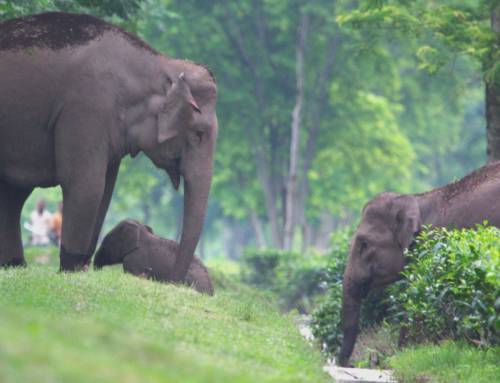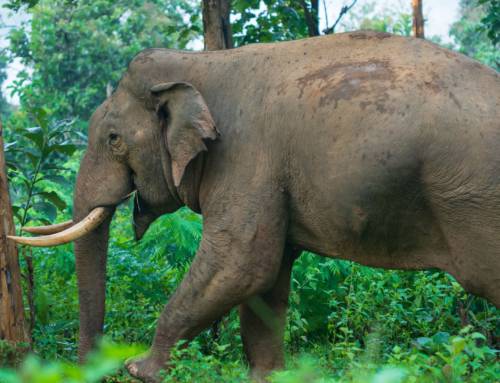Research Article: Kumar, N.S., Harihar, A., O’Kelly, H.J., Pattanavibool, A. (2017). Field Practices: Estimating Abundance of Prey Species Using Line Transect Sampling. In: Karanth, K., Nichols, J. (eds) Methods For Monitoring Tiger And Prey Populations. Springer, Singapore. https://doi.org/10.1007/978-981-10-5436-5_7
Blog Author: Chandan Kumar Pandey
Key Highlights
- The study examined how scientists count wild animals in large forests by walking along straight paths and recording the distance to each animal when it is spotted, similar to a careful wildlife census.
- It was important because using the wrong methods can give misleading numbers, which can harm efforts to protect wildlife.
- Researchers followed strict steps—like walking slowly, staying quiet, and not using easy trails—to avoid scaring animals and to make sure every type of habitat was fairly covered.
- They found that to get trustworthy results, they needed enough animal sightings (usually 60–80 per species), good timing (like dry season mornings), and random paths instead of convenient ones.
- The study shows that good wildlife counting needs both careful planning and flexibility, especially as forests change due to human activity and climate change.
Imagine trying to guess how many jellybeans are in a jar just by looking at a small handful. If you don’t see enough, your guess might be wildly off. Now, think about trying to count animals in a vast forest! Wildlife scientists face this challenge every day, using a method called distance sampling with line transect surveys. However, to get accurate population estimates, they must follow careful steps, ensuring their surveys are precise and unbiased.
The distance sampling approach rests on four fundamental assumptions, each of which must be rigorously upheld to ensure the accuracy of population estimates. First, animals must be randomly distributed across the landscape. This assumption ensures that the transects—straight paths walked by observers—are representative of the entire habitat. Second, all animals directly on the transect line must be detected. If observers miss animals at the line itself, density estimates will be systematically underestimated. Third, animals must be recorded at their initial location when first spotted, rather than after they have fled or moved. Finally, distances and angles to detected animals must be measured with precision, as even small errors can compound into significant inaccuracies.
To meet these assumptions, scientists adhere to strict field protocols. Minimizing disturbance is paramount: observers move quietly, avoid sudden movements, and wear neutral-colored clothing to blend into the environment. Teams often deploy two observers—one focused on the path directly ahead and the other scanning the periphery—to reduce the likelihood of missed detections. Walking speed is carefully regulated to approximately 1.5 kilometers per hour, a pace that balances thorough observation with minimal disruption to wildlife. These protocols, as emphasized by Kumar et al. (2017), are not mere guidelines but non-negotiable requirements. For instance, startling animals into flight violates the assumption of recording their original location, while varying speeds can create inconsistencies in detection effort.
The placement of transect lines is as critical as how scientists walk them. Using pre-existing trails, roads, or other linear features introduces bias, as these paths often skirt dense vegetation or rugged terrain where certain species may congregate or avoid. For example, deer might be overcounted in open areas near trails, while elusive species like mouse deer could go undetected in thick undergrowth. To prevent such skewed results, transects must be placed either randomly or systematically across the study area.
Random placement is akin to throwing darts at a map blindfolded—each transect has an equal chance of intersecting any habitat type. This method ensures that forests, grasslands, wetlands, and other ecosystems are proportionally represented in the survey. Systematic designs, such as grid-based transects spaced at regular intervals, are also used but require careful planning to avoid alignment with human-made features. As underscored in field protocols by Kumar (2017), the goal is to eliminate “convenience bias,” where researchers unconsciously favor accessible or familiar routes. Only through such rigor can scientists produce estimates that reflect true animal densities.
In line transect surveys, sample size is very important for precise estimates. Just as guessing the number of jellybeans in a jar requires seeing enough candies to infer the total, scientists need a minimum of 60–80 sightings per species to generate reliable density estimates. Smaller samples introduce high uncertainty, rendering results statistically weak. For species with naturally low densities, achieving this threshold can be challenging.
To plan effectively, researchers conduct pilot surveys—short test runs that estimate how many kilometers must be walked to reach the target sample size. These preliminary efforts inform decisions about survey duration, team size, and resource allocation. In areas where animal densities are extremely low, scientists may need to increase effort by three to fivefold. When sightings still fall short, they may pool data across multiple years or borrow detection functions—mathematical models that estimate detection probabilities—from similar studies. However, these workarounds carry risks. Pooling data assumes consistent animal behavior over time, while borrowed models may fail if detection rates differ between regions. Kumar et al. (2017) caution that such compromises should be used sparingly and transparently.
The timing of surveys can make or break their success. In South Asia, for example, the optimal window for line transect surveys falls at the end of the dry season. During this period, deciduous trees shed their leaves, improving visibility across the forest floor. Early mornings and late afternoons are preferred, as these are peak activity times for many species, from foraging herbivores to crepuscular predators. Conducting surveys during these hours maximizes detection probabilities while minimizing the physical strain on researchers, who often work in extreme heat.
Seasonal and daily rhythms also influence animal behavior. During monsoon seasons, dense foliage and flooding can obscure sightings, while midday heat in arid regions drives animals to shade, reducing movement. Kumar et al. (2017) stress that aligning surveys with periods of high detectability is not just a logistical choice but a scientific necessity. Failure to do so can lead to underestimates, misinforming conservation strategies.
In habitats ravaged by poaching, deforestation, or climate change, animal densities may plunge to levels where traditional line transect surveys falter. When sightings are too sparse to meet the 60–80 threshold, scientists pivot to alternative strategies. One approach is pooling data over multiple years, though this assumes no significant population fluctuations during the period. Another is borrowing detection functions from studies in similar ecosystems—for instance, applying models developed for tigers in India to a small, isolated population in Southeast Asia. However, this method hinges on the risky assumption that detection probabilities are consistent across regions.
In cases where even these adaptations fall short, researchers may shift to occupancy surveys. Instead of estimating absolute numbers, occupancy methods track habitat use over time, providing a proxy for population trends. While less precise, this approach is invaluable for monitoring critically endangered species or guiding habitat restoration efforts.
The distance sampling approach is a testament to the marriage of scientific rigor and adaptive problem-solving. From randomized transects that eliminate bias to seasonal timing that maximizes detectability, every detail is calibrated to produce data robust enough to inform conservation policy. Yet, the challenges are ever-evolving. As habitats fragment and climates shift, scientists must continually refine their approaches, integrating technologies like camera traps and machine learning. Through it all, the core principles remain unchanged: meticulous planning, unwavering adherence to protocols, and a commitment to understanding ecosystems on their terms. In the end, the numbers generated by these surveys are more than statistics—they are the foundation of efforts to preserve Earth’s biodiversity for generations to come.
To access the original article, click here.
Keywords: Line Transect, How to estimate wildlife population, Wildlife Abundance Estimation, Distance Sampling




